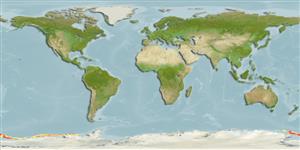Common names from other countries
Classification / Names / Names
Nombres comunes | Sinónimos | Catalog of Fishes (gen., sp.) | ITIS | CoL | WoRMS
Environment: milieu / climate zone / depth range / distribution range
Ecología
; rango de profundidad 250 - 5631 m (Ref. 1662). Temperate; 65°S - , 152°E -
Antarctic Atlantic and Indo-Pacific: From Antarctica to sub-Antarctic islands, South Africa, Madagascar, Europe and South America.
Length at first maturity / Tamaño / Peso / Age
Maturity: Lm ? range ? - ? cm Max length : 0.8 cm H macho / no sexado; (Ref. 1662)
Minimum depth from Ref. 2892.
Life cycle and mating behavior
Madurez | Reproducción | Puesta | Huevos | Fecundidad | Larva
Members of the class Ascidiacea are hermaphroditic; both cross- and self-fertilization is typical. Life cycle: Eggs develop into lecithotrophic larva before metamorphosing into benthic adults.
Sanamyan, K.E. and N.P. Sanamyan. 1999. (Ref. 1662)
IUCN Red List Status (Ref. 130435)
CITES status (Ref. 108899)
Not Evaluated
Not Evaluated
Human uses
| FishSource |
Herramientas
Más información
Age/SizeCrecimientoLength-weightLength-lengthMorfologíaLarvaAbundancia
Fuentes de Internet
Estimates based on models
Preferred temperature
(Ref.
115969): 0.1 - 0.9, mean 0.5 (based on 174 cells).
Vulnerability
Low vulnerability (10 of 100).
Price category
Unknown.
